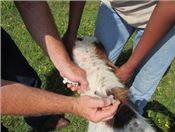Vaccination: Cheap Insurance For Higher Farm, Ranch Profits
PINE BLUFF, ARK.
Vaccines are cheap insurance for higher farm and ranch profits, said David Fernandez, Cooperative Extension livestock specialist at the University of Arkansas at Pine Bluff. Vaccines cost about $3 to $10 per calf and 50 cents to $1 per lamb or kid.
Vaccines protect herds or flocks against often-fatal diseases. Even if the disease is not fatal, several pounds of growth are lost for every sick animal. With calf prices hovering around $2.65 per pound, and kids and lambs at $2 per pound, a single pound lost to disease would nearly cover vaccination costs of calves and more than pay costs for kids and lambs.
“The price of a single animal, calf, lamb or kid, lost to a preventable disease will pay for the vaccination program for an entire herd or flock in most cases,” Fernandez said.
Livestock in Arkansas usually give birth in the spring. Newborns get their immunity from their mother’s milk, but by the time they are two to four months old, that immunity is gone. They must then establish their own. Late May or June is usually the time to vaccinate.
“One of the primary reasons vaccines fail to work is ranchers forget which type of vaccine they are using,” said Dr. Fernandez. There are two kinds of vaccines – killed and modified live. Killed vaccines are made from dead disease-causing organisms. Modified live vaccines are made from weakened or altered microbes that cannot cause disease, but immune systems respond as if there were an infection.
Modified live vaccines must be kept cool and out of direct sunlight. Ultraviolet radiation kills bacteria so the vaccine is damaged. Dr. Fernandez advises checking your medical refrigerator to see if it accurately maintains a temperature between 35 and 45 degrees. In a farm survey by the University of Arkansas in 2008, more than half of the refrigerators failed to keep the temperature range between those values, and only 27 percent kept their temperature 95 percent of the time
Vaccinate calves for blackleg using either a seven-or eight-way vaccine, IBR-BVD-PI3 and leptospirosis before weaning. Most producers also vaccinate heifers for brucellosis between 4 and 12 months of age, he said. Other diseases to vaccinate against include respiratory diseases such as bovine respiratory syncytial virus, pastureurella or Haemophilus somnus. Also, pink eye, anthras and anaplasmosis. Respiratory diseases, pink eye, anthrax and anaplasmosis are optional.Vaccinate lambs and kids for clostridium CD & T. This protects from the two most common forms of overeating disease and tetanus. Schedule this vaccine for about four weeks before they begin eating solid feeds, especially grain, Fernandez said. They can also be vaccinated against caseous lymphadenitis, called CL or cheesy gland.
“Many producers prefer not to vaccinate for CL if it is not already present in their flocks or herds,” Fernandez said. There is a combined vaccine called CD&T/CL for use in lambs, but not in kids. The combined vaccine causes a severe reaction in goats and should never be used on them. Instead, purchase the CL vaccine separately, Fernandez said.
Lambs and kids can also be vaccinated for pasteurella. Work with a veterinarian to develop a plan for other diseases if you have problems specific to your herd or flock. ∆

Vaccines are an inexpensive way to protect your flocks and herds against losses.
UAPB Photo